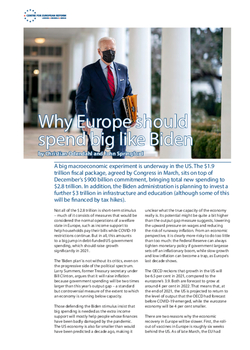
Why Europe should spend big like Biden
The scale of Biden’s spending plans means the US economy will recover much faster than Europe’s. Yet in many ways it is the European economy that is in greater need of stimulus.
A big macroeconomic experiment is underway in the US. The $1.9 trillion fiscal package, agreed by Congress in March, sits on top of December’s $900 billion commitment, bringing total new spending to $2.8 trillion. In addition, the Biden administration is planning to invest a further $3 trillion in infrastructure and education (although some of this will be financed by tax hikes). Not all of the $2.8 trillion is short-term stimulus – much of it consists of measures that would be considered the normal operations of a welfare state in Europe, such as income support to help households pay their bills while COVID-19 restrictions continue. But in all, this amounts to a big jump in debt-funded US government spending, which should raise growth significantly in 2021.
The Biden stimulus and investment plans make the EU’s recovery fund look like small change. Yet it’s the EU that is most in need of stimulus.
The ‘Biden plan’ is not without its critics, even on the progressive side of the political spectrum. Larry Summers, former Treasury secretary under Bill Clinton, argues that it will raise inflation because government spending will be two times larger than this year’s output gap – a standard but controversial measure of the extent to which an economy is running below capacity.
Those defending the Biden stimulus insist that big spending is needed as the extra income support will mostly help people whose finances have been badly damaged by the pandemic. The US economy is also far smaller than would have been predicted a decade ago, making it unclear what the true capacity of the economy really is. Its potential might be quite a bit higher than the output gap measure suggests, lowering the upward pressure on wages and reducing the risk of runaway inflation. From an economic perspective, it is clearly more risky to do too little than too much: the Federal Reserve can always tighten monetary policy if government largesse sets off an inflationary boom, while slow growth and low inflation can become a trap, as Europe’s last decade shows.
The OECD reckons that growth in the US will be 6.5 per cent in 2021, compared to the eurozone’s 3.9. Both are forecast to grow at around 4 per cent in 2022. That means that, at the end of 2021, the US is projected to return to the level of output that the OECD had forecast before COVID-19 emerged, while the eurozone economy will be 4 per cent smaller.
There are two reasons why the economic recovery in Europe will be slower. First, the roll-out of vaccines in Europe is roughly six weeks behind the US. As of late March, the EU had administered 13 doses per 100 people, according to the ‘Our World In Data’ website. The US passed that mark on February 10th. Six weeks is not a huge difference, but there are worrying signs of a third wave of the pandemic hitting Europe, and British and South African variants of the virus may force governments to impose tougher, longer and therefore more costly lockdowns in order to contain them.
The second reason is economic policy. The EU and its member-states had a good start to the pandemic, allowing sizeable ‘automatic stabilisers’ to play out, and adding or extending schemes to keep workers in jobs, support incomes and provide liquidity to firms. Moreover, the EU’s €750 billion debt-financed recovery fund will raise investment spending in the years to come (even if it will not provide much additional spending this year). But it is now up to national governments – some of them highly indebted and at risk of falling foul of Europe’s fiscal rules in the future – to boost their economies further.
In some ways, Europe is more in need of stimulus than the US, yet on current plans its governments will do far less than the Biden administration.
Take corporate debt, which will end up much higher after this pandemic. Over-indebted firms can act as a drag on growth if they cut investment and costs to pay back their creditors. US corporate debt tends to be higher than the eurozone’s, but American companies are on average larger than those in Europe and have access to deeper capital markets, while US bankruptcy procedures tend to be speedier, so higher corporate debt is less of a problem. Gross fixed capital formation – a broad measure of investment – grew a meagre 0.7 per cent a year in the US between 2016 and 2019, a rate that, with some wild quarterly swings, continued in 2020. In the eurozone, however, it shrank by 0.8 per cent a year between 2016 and 2019, before falling by another 1.6 per cent in 2020. That augurs ill for the recovery, with higher corporate debt as a result of the pandemic curbing hiring and investment more in Europe than in the US.
The increase in corporate debt after this pandemic is likely to hurt the EU economy more than the US’s. Does Europe need a Biden stimulus more urgently than the US?
Households’ finances on both sides of the Atlantic look similar, however. In both the US and the EU, the financial costs of COVID-19 have been concentrated on lower income workers, many of whom have either been furloughed or have lost their jobs. People in office jobs have built up savings as a result of having fewer opportunities to spend. With luck, a splurge of spending – on holidays, meals and entertainment – once restrictions are lifted could lead to a rapid rehiring of workers in the hospitality sector. Evidence on both sides of the Atlantic suggests that a decent chunk of households’ higher wealth will be consumed – around 10-15 per cent. But it is unlikely that all of the foregone consumption from periods of lockdown will be recovered, and surveys suggest most people are planning to pay down debts or maintain a higher level of savings.
However, the European economy entered the pandemic in a low-inflation, low-growth equilibrium, and may well return to that without aggressive fiscal stimulus. The eurozone’s inflation outlook is weak, just as it had been going into the pandemic. Investors and official bodies do not think that consumer spending will rapidly close the gap between aggregate demand and the supply capacity of the economy once restrictions are lifted. US long-term inflation expectations, however, are well anchored on the US inflation target, thanks in part to the Biden stimulus.
For these reasons, Europe’s governments should be introducing enough fiscal stimulus to push the economy back to its potential output, and the ECB needs to continue signalling that it would not react to a burst of inflation with tighter policy (if it considers higher inflation to be temporary). Given the balance of risks, it is worth testing the extent to which the economy can cope with higher expenditure without a large rise in inflation. Policy-makers might be surprised, considering that before the pandemic unemployment rates in Germany, the Netherlands, Britain and elsewhere in northern Europe had fallen to very low levels without generating wage growth and hence inflation. And the recovery fund, if spent wisely, should help to expand the supply capacity of the European economy.
If it turns out that fiscal policy is overdone, and the ECB considers longer-term inflation expectations to be rising too high, the usual central bank tools to cool the economy will work. Quantitative easing can be slowly and methodically unwound, with the ECB selling government bonds to the private sector, raising interest rates across the economy. And short-term interest rates can be raised too. Given the balance of risks – especially the desperate need to avoid another lost decade of economic stagnation and political instability – Europeans must loosen the fiscal taps, and spend big like Biden.
Christian Odendahl is chief economist and John Springford is deputy director at the Centre for European Reform.

